| 1 | Reticulated python |
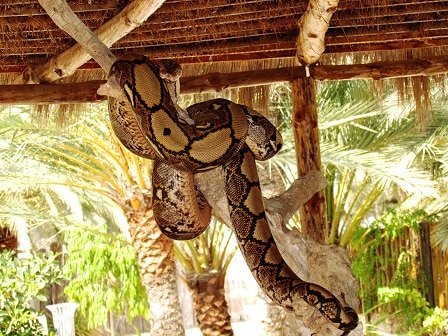
A resident of south-east Asia, including Thailand, Malaysia and Indonesia. The reticulated python can reach gargantuan lengths. It holds the unofficial record for longest individual snake of all time, a 10 metre monster shot dead in Celebes, northern Sulawesi in 1912. Because this was near a mining camp, there were civil engineers on site to perform a scientific measurement.
It could be true or it could be false – no proof survives today (unless it’s stashed in someone’s attic). But what’s beyond doubt is that reticulated pythons regularly exceed 6 metres, with the longest official measurement in the wild being 6.95 metres in 1999, a snake from Borneo. This snake was so huge that it swallowed a small sunbear, and spent several weeks in a hollow log digesting.
Reticulated pythons regularly eat pigs, deer, dogs, and even small children. In the Philippines, the Agta tribe has been waging a tireless war on them for decades. In Thailand, they regularly drape themselves across entire roads and block people.
The longest ever snake in captivity (officially confirmed) was a reticulated python, called Medusa who lived in “The Edge of Hell Haunted House” in Kansas City. During measurement in 2011, she had to be held by 15 people, and the final result was 7.67 metres. Less officially but maybe still truthfully, the captive “Samantha” measured 7.92m in 2002, while “Fluffy” measured 7.3m in 2010.
| 2 | Green anacadona |
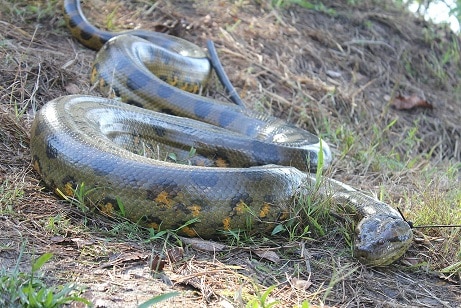
For many years, Bronx Zoo had a $50,000 dollar reward up for grabs, initiated by President Teddy Roosevelt, for information leading to a 30 feet+ (9.144 metres) anaconda. No-one ever succeeded, but for average length, the green anaconda of South America is the second largest snake on Earth.
A giant study was conducted by Dr. Jesús Antonio Rivas, an expert on the species. He analysed 1000 wild green anacondas in total, and found that the longest was 5.21 metres. Unconfirmed but credible reports of 5.6 and 6.27 metres have also circulated the rumour mill. The minimum adult length is 3.2 metres, and the average in the huge study was 3.7 metres, enough to fill a moderately sized hallway.
It’s said that green anacondas grow the largest in thickly forested riverside areas. Their diet includes such huge animals as spectacled caimans, red side-necked turtles, red-footed tortoise, deer and capybaras.
In 2018, the rumour mill exploded when a supposedly 50 foot anaconda was filmed swimming across a river in Brazil. The video went viral on facebook, but the video was clearly digitally altered: it had been stretched sideways from vertical mode to fill the entire screen, massively elongating the snake. The river was actually a flooded road, and the original unedited video was soon tracked down. Yet the real anaconda shown was still gigantic.
| 3 | African rock python |
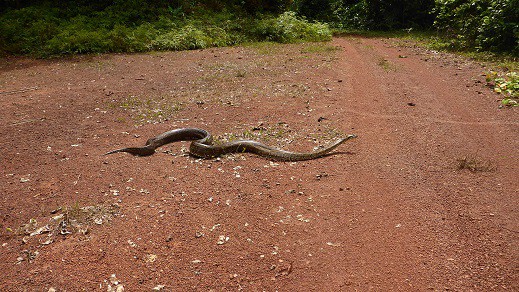
The central African rock python is the undisputed longest snake in Africa. Its average length is 3-3.5 metres, but above 4 metres are common, and unproven reports of 7 metre titans aren’t unusual. It tops this off with an exceptionally thick body, making for a maximum weight of 200 pounds.
There are stories of monster African rock pythons aplenty. In 1932, a 9.81m python was supposedly shot dead by Mrs Charles Beart, in the grounds of a school in Ivory Coast. Another Ivory coast python was reported at 7.3 metres – they grow largest in the west of Africa.
Their meals are enormous. In 2017, some hyena researchers came across a small boulder submerged in a swamp. Except that it wasn’t a boulder – it was an African rock python with a 150 pound hyena (fortunately not one of their research subjects) in its belly. This is believed to be the largest snake prey ever recorded. A story from 1958 has K..H. Kroft finding a 7 metre African rock python with a Nile crocodile in its stomach, measuring 1.5 metres.
African rock pythons are large enough to attack humans, such as one that seized a 13 year old boy in 1979. His friends fled and returned with a village elder 20 minutes later, who attacked the python with a pick axe, but suffered a dislocated arm when the giant serpent seized the pickaxe with its mouth. The boy was dragged free but already dead, with his head covered in saliva. The python was tracked for 0.5 miles to an overhanging rock where it lay coiled, and dragged alive to the coroners office, who measured it at 4.5 metres.
| 4 | Scrub python |
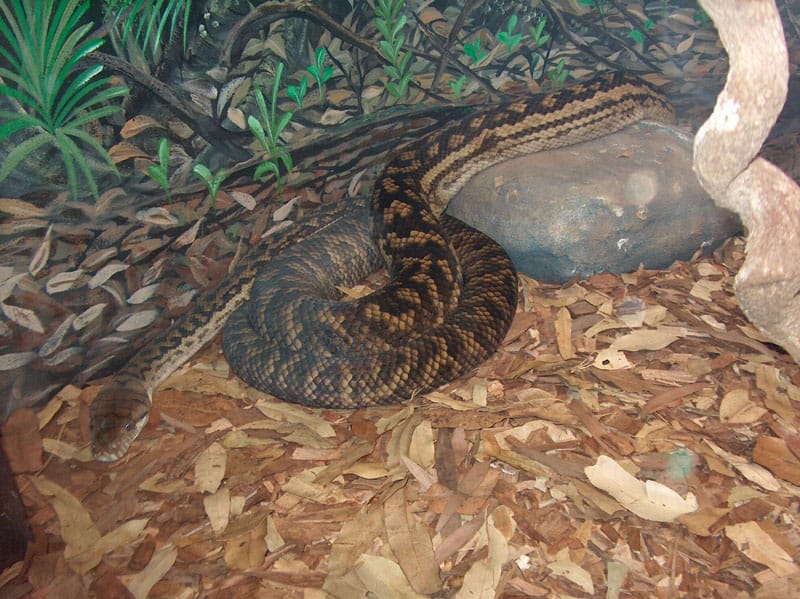
Australia’s largest snake, once thought to be the same species as the amethystine python, but actually independent, and even larger. Scrub pythons reach a maximum confirmed length of 5.65 metres, a female caught in Palm Cove near Cairns in 2000. The largest male ever caught measured 5.33 metres from Kuranda in 2002.
Scrub pythons live in the forests of Australia’s far north, particularly Queensland. Their diet consists of mammals and birds, including small wallabies and kangaroos, spectacled flying foxes (a megabat), bush rats, and bandicoots. One of the largest officially confirmed meals was a 22 pound wallaby, devoured by a 4.4 metre scrub python.
Making matters worse, there’s a gorge in northern Australia called Tully River Gorge where huge amounts of scrub pythons congregate at once. The largest males will slither down in the dry season, to fight each other and lay claims of reproduction. The snakes in this gorge ranged from 1.3-3.76 metres, in a study from 2005. With their gigantic size comes gigantic travel, as some were able to travel 1.3km in an entire day. It’s a two sided coin: the largest males mated with females the most, but also had the most territorial battles and combat wounds on their bodies.
| 5 | Burmese python |
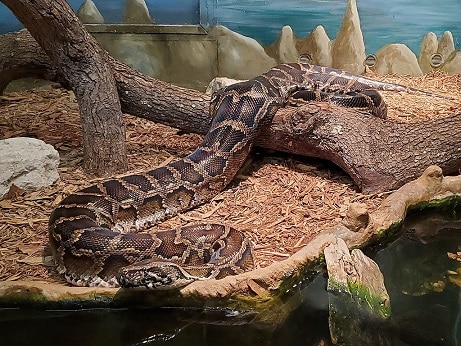
An invader of the Florida everglades, and native to India and Myanmar (AKA Burma). The Burmese python is one of the hungriest, greediest looking snakes around. It’s also long, with an average of 3.7 metres, and a thick body to match.
The longest officially recognised Burmese python was “Baby”, a captive who clocked in at 5.74 metres very shortly after her death at age 27. Captive snakes can be fed to their heart’s content, but the wild records are barely behind. They include 5.2 metres in April 2019, 5.72 metres in 2013, and 5.5 metres in December 2021. With its new home in the Florida evergreens (although eradication efforts are underway), this is an easier giant snake for western scientists to measure than others.
Burmese pythons swallow pigs and deer in captivity, and try to eat alligators in the wild. One X-ray showed the brutal results of ingesting a 50cm young gator. It revealed how the python’s metabolism accelerated 40 fold, a flood of stomach acid and digestive enzymes were unleashed, and its heart and kidneys enlarged by 40% and 72% respectively. There was also a viral photo around 2005 showing a Burmese python that supposedly exploded after trying to eat a 6 foot gator – nobody has ever proven whether this is real (or fake).
| 6 | King cobra |
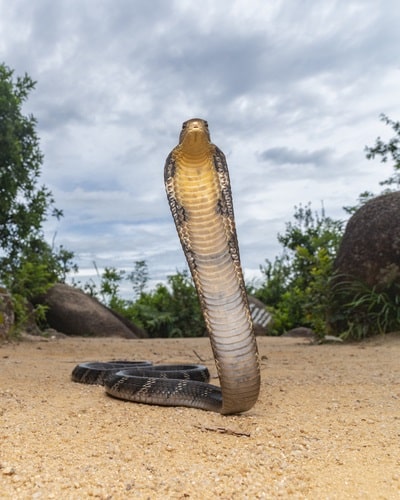
The undisputed length leader among venomous snakes. The king cobra really is the king in certain ways – extremely long, with an official wild maximum of 5.54m recorded in 1937. This individual was captured in Negeri Sembilan state on the Malay Peninsula, and by 1939, it had reached 5.71 metres. The cobra lived a healthy life in London Zoo, until World War 2 broke out and the curators euthanised the snake over fears that German bombings could help it to escape and roam the streets. Whispers of 5.5 metre snakes circle traditional Thai villages constantly.
The king cobra’s massive length allows it to jump 1 metre off the ground when striking, and almost as far when baring its fangs in its classic intimidation pose. The king cobra is ophiophagous – a snake that eats other snakes – and its huge length allows it to eat oriental ratsnakes, Indian cobras, and mangrove snakes. They even eat reticulated pythons, and a 2.79 metre python may be its longest recorded meal. The cobra itself was 3.66 metres. One king cobra studied ate 13.7 metres of snakes from July to March – this cobra measured 4.34 metres.
A more thorough study analysed dozens of king cobras in Kerala, and found a male maximum of 3.75 metres, and female maximum of 2.75 metres.
| 7 | Oenpelli’s python |
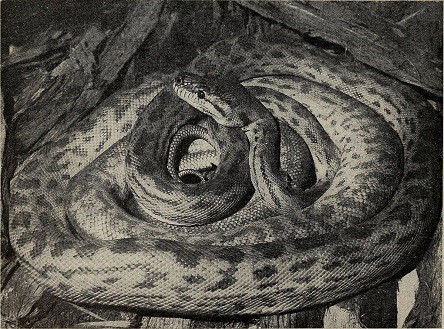
The rarest long snake, and possibly the Australia’s rarest python. It’s called the ghost because there’s only 10,000, and they live in deep soil chasms in Australia’s scorched northern regions. Gavin Bedford once spent 1100 hours searching for one with helicopter assistance, before he finally lucked out and saw one lying lazily on the baked Earth (which was pretty anticlimatic).
The Oenpelli python is Australia’s second longest snake, regularly reaching over 4 metres. Rumour states that a 5 metre one lurks in captivity somewhere. Their eggs are particularly gigantic, averaging at 11 by 6cm. The difference to others is that the Oenpelli python is very thin for its length. It’s a constrictor, but far less muscular and bulky, more like a hosepipe than a fallen log. The Oenpelli python is an influential character in Aboriginal folklore, possibly inspiring the ancient rainbow serpent myths.
Being so unstudied, there are few sightings of Oenpelli pythons eating massive prey. But its diet is believed to include possums, birds, rodents, and possibly small kangaroos and wallabies.
| 8 | Cuban boa |
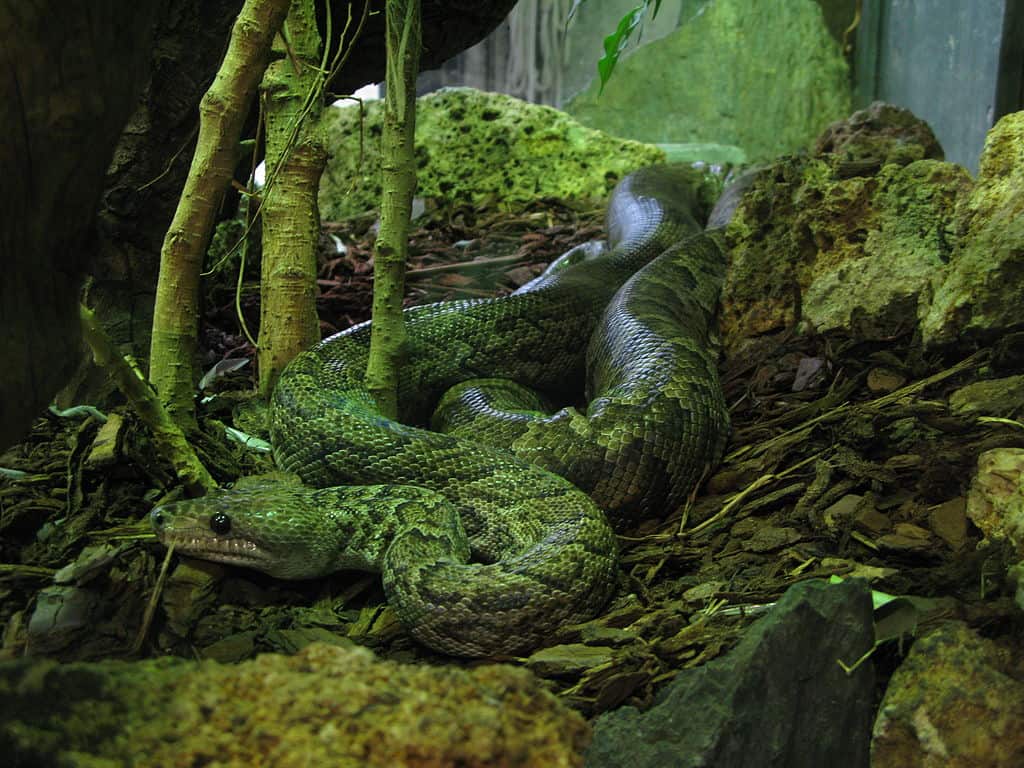
Forget the boa constrictor – the Cuban boa easily outstrips it for sheer size. The early European colonisers were shocked at the size of the native boas. They wrote in their journals of snakes as thick as a man’s thigh and measuring 9.12 metres. More recently, in 1989, a 4.85 metre female was run over near Guantanamo Naval Base. The largest scientifically recorded Cuban boa measured 6.65 metres, after which a whole goat tumbled out of its stomach.
In fact, Cuba is unusual for Caribbean islands in that it only has 1 boa species. It’s believed that the early colonisation by such a giant boa forced all the others to stay away.
Why so low on the list? 200 years ago, the Cuban boa would be higher, but there’s strong evidence that they’ve shrunk in recent years. Similarly to the mamushi in Japan, the more human agriculture encroaches upon the Cuban boa’s habitat, the more the 5 metre versions disappear. These days, 3 metres is considered to be long. The reason is simply fearful farmers and villagers being more likely to club the huge ones to death, steadily wiping out the gigantic genes.
| 9 | Olive python |
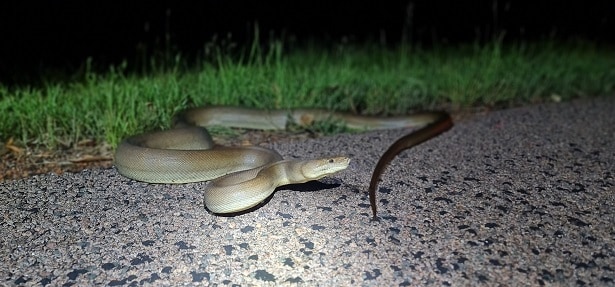
Australia’s third largest snake, residing in the far north, and no additional countries. The olive python regularly reaches 4 metres, and has the claim to fame of fitting a freshwater crocodile in its belly. In Lake Moondara in northern Queensland, the two were spotted in a terrible struggle in the shallow lakeside waters. The olive python barely seemed to fit around its prey, but the constriction eventually worked, after which the olive python dragged the crocodile to shore, swallowing it over the course of 15 minutes. The video was widely reported by the international media – everyone else vowed to move further away from Australia.
Despite their bulk, olive pythons are great swimmers. They also hunt rock wallabies, fruit bats, ducks and spinifex pigeons.
In 2021, a man entered public toilets near Darwin and saw an olive python across an entire cubicle. He retreated and entered the adjacent cubicle. No luck – the snake was so long it was covering two. The most horrific thing is that the olive python had an even longer ancestor. It belongs to the family Liasis, and the extinct Liasis dubudingala was believed to measure 9 metres, based on vertebra unearthed in northeast Queensland. It was named the Bluff Down’s giant python.
| 10 | Black mamba |

The black mamba also fell victim to the viral craze crew recently, when photos circulated facebook of a 6 metre monster mamba, which really turned out to be an Australian sculpture. Nevertheless, the black mamba is the second longest venomous snake in the world, and the longest in Africa. Black mambas are thin like a twig, but average at 2 metres, and commonly reach 3 metres. This South African snake catcher reported that 4.1 metres was his longest sighting, over an experienced career.
The official record is 4.4 metres in Zimbabwe, but African village elders will laugh at this and inform you of 6 metre monsters. The black mamba is feared for its aggression, and during its lighting fast strike, it can raise its body a third off the ground, often up to 1.2 metres. Black mambas are huge from the moment they’re born. Hatchlings measure 40-60cm, longer than an adult ringneck snake. They can reach 2 metres after just 1 year.
Because of its thin body, black mambas rarely attack huge prey. The average size was 1.9–7.8% of the black mamba’s body mass, but they are known to swallow mammals like rock hyraxes and dassies.
